Hannah Byron's Blog, page 2
February 27, 2025
The Echo of Valor, Codename Rose – Now Available!

I am beyond excited to share that The Echo of Valor, Codename Rose, the second book in my Timeless Agents series, is now live! This book holds a very special place in my heart, as it tells the incredible story of Eileen Nearne, a courageous SOE agent of Section F, and Mia, the contemporary truama therapist, whose journey intertwines with Eileen and her legacy.
One of the most deeply meaningful aspects of this release is the endorsement from Eileen Nearne’s family. I am truly honored that they have not only supported the book but have also given their blessing for me to dedicate it to Eileen’s beloved late niece, Odile Nearne. This recognition means the world to me, and I hope that The Echo of Valor does justice to Eileen’s bravery and resilience.

Odile and Eileen Nearne (Torquay 2009)
As the story of Eileen and Mia, and of course love interest Sebastian Stone, is so important to me, I sincerely hope this book will resonate with readers just as much as it has with me. The journey of writing this book has been both emotional and rewarding, and I am thrilled to finally share it with you all.
With The Echo of Valor, I am proud to have now told the stories of two remarkable SOE agents of Section F—Eileen Nearne and Lise de Baissac, the heroine of The Color of Courage. Their courage, sacrifices, and legacies deserve to be remembered, and I look forward to bringing the rest of the Timeless Agents series to you in the future.
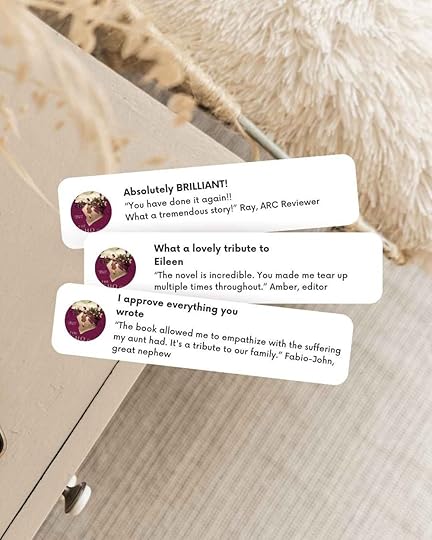
I have been so moved by the early reactions and reviews from my ARC team, and I can’t wait to hear what you think! If you’ve read The Echo of Valor, I would love for you to share your review on:
Amazon (https://mybook.to/EchoofValor)
Goodreads (https://www.goodreads.com/book/show/211426139-the-echo-of-valor)
and/or BookBub ()
Thank you all for your support, and I hope you enjoy The Echo of Valor!
Grab your copy now and join me in honoring the extraordinary legacy of Eileen Nearne.

Eileen Nearne
Click to view The Echo of Valor on AmazonThis button or link takes you to The Echo of Valor on Amazon regardless of your country: https://mybook.to/EchoofValor
February 1, 2025
Revolutionary Roles: Women’s Military Uniforms in WWII
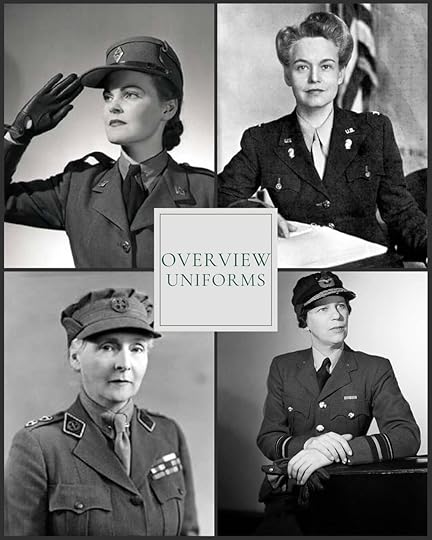
World War II marked a turning point in history—not just on the battlefield but in how societies redefined roles for women. For the first time, women donned official military uniforms, stepping into roles that challenged traditional gender norms and showcased their courage, skill, and resilience. From the Women’s Auxiliary Air Force (WAAF) to the First Aid Nursing Yeomanry (FANY), these uniforms symbolized a blend of functionality and groundbreaking progress.
Each of the uniforms featured in this blog post—WAAF, FANY, ATS, CWAC, AWAS, and WAC—represents women’s invaluable contributions to the war effort. While this blog focuses on these specific groups, countless others, including nurses and pilots, also wore uniforms that made history.
It’s important to recognize that this blogpost highlights only a few of the many roles women played in WWII. Their contributions spanned far beyond these groups, with numerous unsung heroines working tirelessly behind the scenes and in active service.
Join me as we explore the stories behind these iconic uniforms, the brave women who wore them, and the revolutionary shift they represented in military and social history.
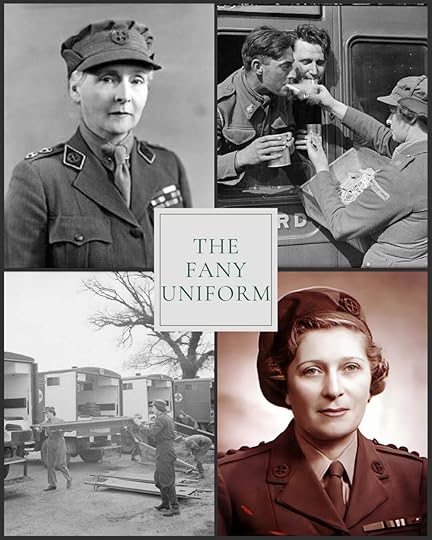
Click image for larger size
FANY Uniforms: A Story of Service and Secrecy
The First Aid Nursing Yeomanry (FANY) played a crucial role during World War II, with its members serving in communications, intelligence, and field operations. Many women agents, including Lise de Baissac and Eileen Nearne, operated under the guise of being part of the FANY. This "cover" provided a layer of official protection while they carried out their daring missions behind enemy lines. The FANY uniform, distinguished by its practical design and smart tailoring, embodied the resilience and courage of the women who wore it.
While the FANY began as a nursing organization, by WWII, its members took on far more diverse and dangerous roles, from radio operators to drivers in active war zones. The uniform was not just a symbol of their service but also a part of the secrecy that made their contributions possible.
Learn more about the FANY and the women who made history in these uniforms here https://www.fany.org.uk/History
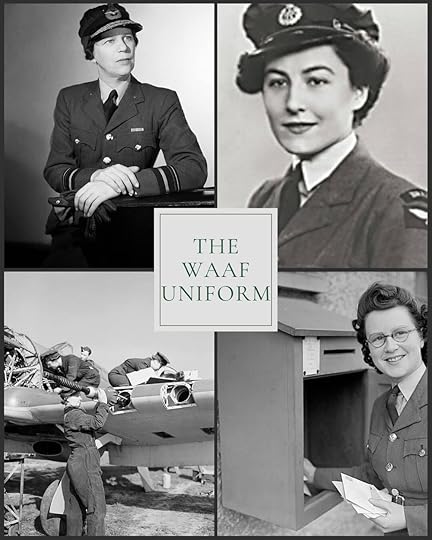
Click image for larger size
WAAF Uniforms: Service in the Skies and Beyond
The Women’s Auxiliary Air Force (WAAF) was established during World War II, and its uniform symbolized a new era of women's active involvement in the military. Unlike some other organizations, WAAF members were given official ranks, marking their roles as integral and not just voluntary. Women like Muriel Byck and Noor Inayat Khan, both SOE agents, wore the WAAF uniform as a form of protection and cover for their clandestine missions.
The uniform itself was practical yet smartly designed, consisting of a blue-grey jacket, skirt, and cap, reflecting its connection to the Royal Air Force. Women in the WAAF served in a variety of roles, from clerks and drivers to wireless operators and radar mechanics. For agents like Muriel and Noor, the uniform provided a semblance of legitimacy as they carried out dangerous operations behind enemy lines.
While Noor Inayat Khan tragically lost her life in service, her story, alongside Muriel’s, underscores the immense courage and sacrifice of WAAF members who shaped the war effort in both visible and hidden ways.
Dive deeper into the history of the WAAF and the women who served with bravery here https://rafhornchurch.com/history/waaf/
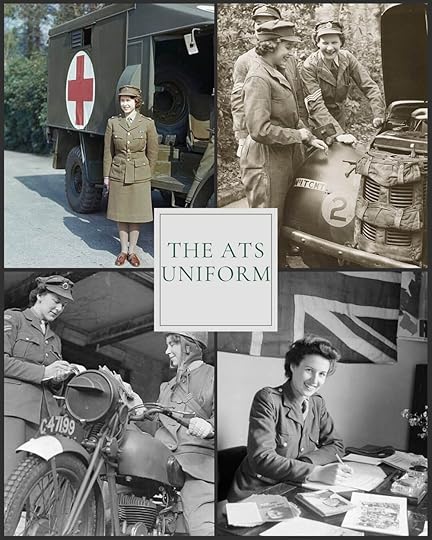
Click image for larger size
ATS Uniforms: Service on the Home Front
The Auxiliary Territorial Service (ATS), the women’s branch of the British Army during World War II, was a vital part of the military effort. Its uniform, consisting of a khaki jacket, skirt, and cap, mirrored that of their male counterparts while being tailored to women. The ATS uniform symbolized the expanding roles of women, from clerks and cooks to mechanics, drivers, and anti-aircraft gunners.
Among the many women who wore the ATS uniform was Princess Elizabeth, the late-Queen Elizabeth II, who joined the ATS in 1945 as a second subaltern. She trained as a driver and mechanic, becoming the first female member of the royal family to serve in the armed forces. Her service in the ATS not only reflected her dedication but also served as a powerful symbol of solidarity with the people during the war.
The ATS uniform showcased practicality and professionalism, blending the need for functionality with military decorum. For the women who wore it, including Princess Elizabeth, it represented a sense of duty and pride in their contribution to the war effort.
Explore the stories of the ATS and its extraordinary members here https://www.nam.ac.uk/explore/war-glamour

Click image for larger size
WAC Uniforms: Pioneering Roles in the U.S. Military
The Women’s Army Corps (WAC), established in 1943, marked a significant shift in the U.S. military, allowing women to serve in non-combat roles with official military status. The WAC uniform, designed with practicality and professionalism in mind, included a tailored olive-drab jacket, skirt, and hat, reflecting the military standards of the time.
One of the most notable figures of the WAC was Oveta Culp Hobby, the Corps’ first director. A trailblazing leader, she guided the WAC through its formative years, ensuring women’s roles were respected and impactful. Under her leadership, WAC members served in over 200 job roles, including clerks, radio operators, mechanics, and cryptographers, freeing up men for combat roles and proving the invaluable contributions of women in the armed forces.
The WAC uniform became a symbol of progress and determination, as women stepped into roles traditionally held by men, breaking barriers and reshaping the perception of women in the military.
Learn more about the Women’s Army Corps and its pioneering members here https://unwritten-record.blogs.archives.gov/2013/06/03/dont-walk-like-a-man-be-the-best-wac-that-you-can-be/

Click image for larger size
CWAC Uniforms: Canadian Women’s Contributions to the War Effort
The Canadian Women’s Army Corps (CWAC) was formed in 1941, allowing women to officially enlist in the Canadian Army for the first time. The CWAC uniform, a smartly tailored khaki jacket and skirt paired with a peaked cap, represented professionalism and pride in service. It was designed to provide women with practicality and a sense of equality within the military.
Among the many women who served in the CWAC, Joan Kennedy stands out as a trailblazer. As one of the first officers in the Corps, she was instrumental in recruiting and organizing women for military roles. Under her leadership, CWAC members served in critical support positions, such as clerks, typists, drivers, and medical aides, enabling male soldiers to focus on combat duties.
The CWAC uniform became a powerful symbol of Canadian women’s vital role in the war effort. These women not only contributed to the Allied victory but also paved the way for future generations of women in the armed forces.
Discover the inspiring stories of the CWAC and the women who shaped history here https://www.thecanadianencyclopedia.ca/en/article/canadian-womens-army-corps

Click image for larger size
AWAS Uniforms: Australian Women Supporting the War Effort
The Australian Women’s Army Service (AWAS), formed in 1941, was the first time Australian women were allowed to serve in the army. The AWAS uniform, featuring a khaki jacket, skirt, and slouch hat, reflected the unique identity of Australian servicewomen. Designed for practicality and function, it became a symbol of their commitment and dedication.
One of the most notable figures in the AWAS was Sybil Irving, its founder and controller. A visionary leader, Irving worked tirelessly to organize and expand the AWAS, ensuring women were prepared and equipped to serve in roles such as clerks, drivers, signal operators, and even anti-aircraft personnel. Under her guidance, the AWAS became a vital part of Australia’s war effort, allowing men to be deployed to combat roles.
The AWAS uniform represented more than just military service; it embodied the pioneering spirit of Australian women who stepped forward to serve their country during its time of need.
Explore the history of the AWAS and the incredible women who wore the uniform here https://vwma.org.au/explore/units/3423
January 28, 2025
Faceless and Forgotten: The Lost Legacy of Madeleine Lavigne

No known photograph of her exists. No memorial bears her likeness. Yet, Madeleine Lavigne was one of the most extraordinary female agents of the Special Operations Executive (SOE), a woman who risked everything in the fight against Nazi occupation. Born on February 6, 1912, in Lyon, France, she dedicated nearly four years to resistance work—creating false identity documents, aiding Allied airmen, and eventually operating as a wireless operator under the codename Isabelle. Despite her courage, her image has been lost to history.
Lavigne's work began at the Lyon town hall, where she used her position to forge documents for those in danger. By 1943, she had become more deeply involved, acting as a courier and providing shelter for SOE agents like Henri Borosh. When the Gestapo closed in, she was forced to flee to England, where she underwent para-military and wireless training before parachuting back into France in May 1944 to establish the Silversmith network in Reims.
Her mission was critical—she kept vital communication lines open, coordinated supply drops, and ensured that resistance efforts remained strong in the final months of the war. When Reims was liberated in August 1944, she was reunited with her children in Paris. But instead of living to see peace fully restored, she passed away on February 24, 1945, from an embolism, leaving behind a legacy that, without images or widespread recognition, has faded into obscurity.
Though history has erased her face, her courage endures. Madeleine Lavigne was posthumously honored with the King’s Commendation for Brave Conduct and the King’s Medal for Brave Conduct, a testament to her silent yet vital contribution to the war effort. But beyond official records, she remains a ghost of history—one of the many women who fought and died without the world ever truly knowing their names, let alone their faces.
Perhaps that is why remembering Madeleine is so important. Because heroines should not remain faceless. Because their sacrifices should never be forgotten. Wait until you’ll find out how a modern-day Marianne Latour pursues Madeleine’s picture in “The Shadow of Silence, Codename Isabelle”.
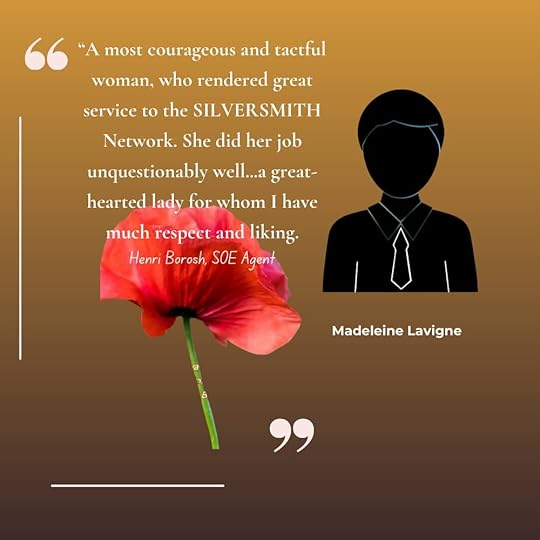
January 8, 2025
New Recipe Book: A Taste of Wartime Cooking

I’m thrilled to announce the release of my new recipe booklet, A Taste of Wartime Cooking: Wartime Recipes for the Modern Kitchen. This collection of 15 recipes is inspired by the incredible resilience and resourcefulness of those who cooked during the Second World War. It’s free to download, and you can grab your copy here: Download the RecipeBook.
Why Wartime Recipes?
During WWII, rationing forced cooks to get creative, making the most of every ingredient while stretching rations to feed their families. Despite these challenges, they managed to create meals that were not only practical but also comforting and delicious. This booklet pays tribute to their ingenuity and the simple but hearty dishes that became staples of the time.
The recipes in this collection range from savory favorites like Cold Meat Pasties and Guernsey Potato Peel Pie to sweet treats like Brown Betty and Wartime Chocolate Layer Cake. Each one is a small piece of history, adapted to be recreated in your own kitchen with modern ingredients.
How This Booklet Came to Be
The idea for this recipe collection began in my Facebook Reader Group, where I shared wartime recipes during our December theme. The response was overwhelming, with so many of you sharing your enthusiasm and even trying out the dishes yourselves. It was clear these recipes resonated, and I wanted to gather them into a single, easy-to-access booklet as a way of continuing the conversation and celebrating this shared love of history and food.

What’s Next?
This is just the beginning! I plan to create a second recipe booklet next December, featuring even more wartime-inspired dishes as we revisit this theme in the Reader group. In the meantime, I’d love to hear your feedback—what recipes did you enjoy most, how did they turn out, and what would you like to see in the next collection?
Get Your Free Copy!
Download your free copy of A Taste of Wartime Cooking: Wartime Recipes for the Modern Kitchen here: https://BookHip.com/WHDKCCX.
Thank you for joining me on this journey into the kitchens of the past. Let’s honor the creativity and resilience of those who came before us while sharing the joy of cooking with loved ones today.
Happy cooking!
Hannah Byron
January 1, 2025
January’s Brave Souls of the SOE
As we step into 2025, I invite you to join me on a year-long journey to honor the extraordinary women of the Special Operations Executive’s (SOE) Section F. These courageous women risked everything to fight for freedom during World War II, their bravery, resilience, and sacrifices becoming a lasting testament to the human spirit in the face of tyranny.
Each month, I’ll commemorate the birthdays of these 39 remarkable agents who served in France, often at great personal cost. By the end of the year, we’ll have remembered them all—each story, each life, each sacrifice.
This tribute ties into my passion for bringing their daring missions to life in my Timeless Agents series, which pairs the journeys of these wartime heroines with fictional contemporary women who navigate their 21st-century challenges. Through these dual timelines, I explore themes of female courage, resilience, and the enduring impact of history on our present lives.
January begins with a poignant reflection. Of the six agents born this month, only one survived the war. The five others lost their lives in the fight for liberty.
These secret agents should never be forgotten. By sharing their stories, we ensure their courage lives on, igniting a sense of gratitude and admiration in every generation. They inspire my writing and research and remind me daily why their legacy is worth preserving. Let their memory remind us of the values they fought for—freedom, justice, and hope—and inspire us to uphold them in our own lives.

Noor Inayat Khan, born on January 1, 1914, in Moscow and of Indian descent was a princess by birth. Trained as a wireless operator by the Special Operations Executive (SOE) she was sent into occupied France in June 1943 with the code name Madeleine, despite being a pacifist by nature. Dodging the constant threat of capture, Noor’s unwavering commitment to her mission for the CINEMA network exemplified her extraordinary courage. Tragically, she was betrayed, captured by the Gestapo in October 1943, and after a horrendous year of captivity and many escape attempts, was executed at Dachau concentration camp on September 13, 1944. Posthumously, Noor was awarded the George Cross, reflecting the profound impact of her sacrifice in the pursuit of freedom.

Maureen Patricia O’Sullivan, known as “Paddy,” was born on January 3, 1918, in Dublin, Ireland. Fluent in French, she was recruited by SOE to serve as a wireless operator in occupied France. Parachuting into France in March 1944, with codename Josette, she played a crucial role in the FIREMAN network. Despite the constant danger, Paddy’s resilience and dedication were instrumental in supporting the French Resistance. Remarkably, she was the only SOE female agent born in January to survive the war. For her bravery, she was awarded the Member of the Order of the British Empire (MBE) and the French Croix de Guerre.
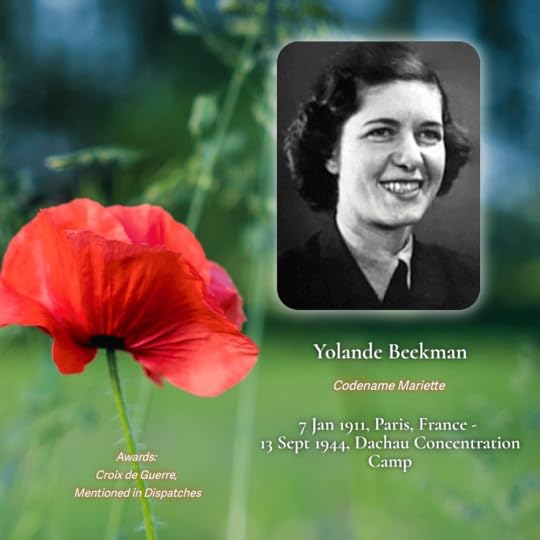
Yolande Elsa Maria Beekman, born on January 7, 1911, in Paris to a Swiss father and English mother, moved to London as a child, becoming fluent in English, German, and French. During World War II, she joined the Women’s Auxiliary Air Force (WAAF) and trained as a wireless operator. Her linguistic skills and technical expertise led to her recruitment by the SOE. In September 1943, under the codename “Mariette,” she was deployed to France as a wireless operator for the MUSICIAN network. Despite the constant threat of detection, she maintained vital communications between the Resistance and London. In January 1944, Beekman was arrested by the Gestapo, endured harsh interrogations, and was eventually deported to Dachau concentration camp, where she was executed on September 13, 1944. Her unwavering bravery and sacrifice were posthumously honored with the Croix de Guerre and a Mention in Dispatches.
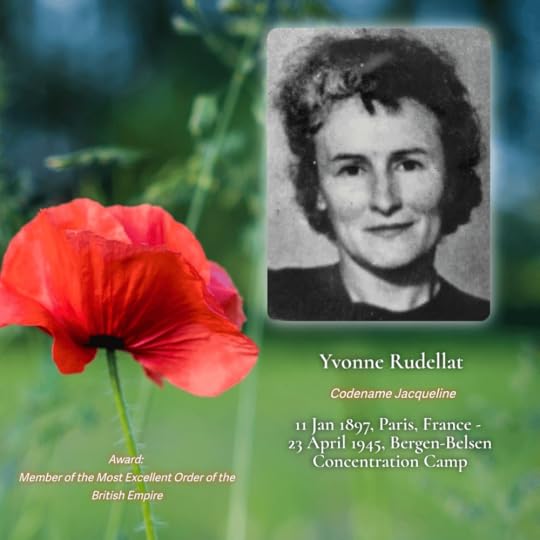
Yvonne Claire Rudellat, born on January 11, 1897, in Maisons-Laffitte, France, became the first female SOE-trained agent to be deployed to France during World War II. Operating under the codename “Jacqueline,” she served as a courier for the PROSPER network, facilitating communications and coordinating sabotage efforts against German forces. Her dedication and bravery were instrumental in supporting the French Resistance. In June 1943, Rudellat was captured by the Germans and endured imprisonment under harsh conditions. Tragically, she succumbed to typhus in Bergen-Belsen concentration camp on April 23 or 24, 1945, shortly after the camp’s liberation. In recognition of her valor, she was posthumously appointed a Member of the Order of the British Empire (MBE).
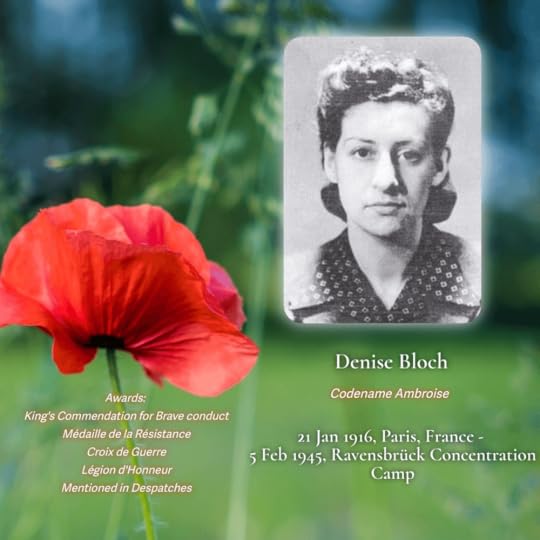
Denise Madeleine Bloch, born on January 21, 1916, in Paris, was a courageous French-Jewish SOE agent. After her family evaded Nazi persecution by relocating to Lyon, Denise joined the French Resistance, demonstrating exceptional bravery as a courier and wireless operator for the CLERGYMAN network. In March 1944, codenamed Ambroise, she was clandestinely flown into central France to support sabotage missions against German forces for the DETECTIVE network. Unfortunately, in June 1944, Denise was captured by the Gestapo and endured severe interrogations. Deported to Ravensbrück concentration camp, she was executed on February 5, 1945. Her unwavering dedication and sacrifice were posthumously honored with the Légion d’honneur, Médaille de la Résistance, and Croix de Guerre.
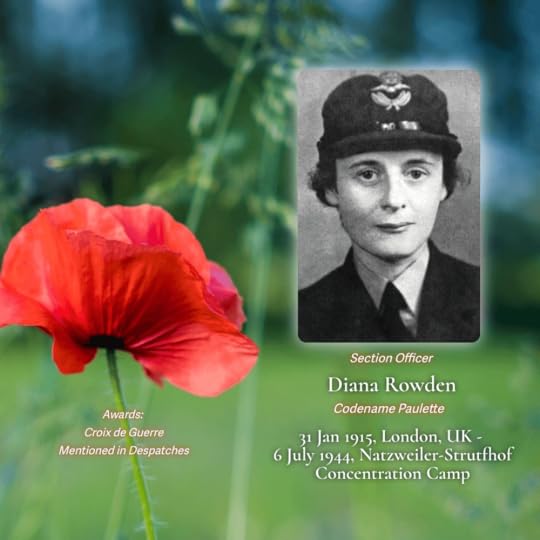
Diana Hope Rowden, born on January 31, 1915, in England, joined the Women’s Auxiliary Air Force (WAAF), before being recruited by the SOE and deployed to France in 1943 as a courier for the ACROBAT network, operating under the codename Paulette. Her work involved coordinating sabotage efforts and maintaining vital communications to disrupt German operations. In November 1943, Rowden was arrested by the Gestapo and later deported to Natzweiler-Struthof concentration camp, where she was executed on July 6, 1944. Her bravery and sacrifice were posthumously recognized with the Croix de Guerre and a Mention in Despatches.
Though January’s record was harrowing, most months will thankfully see more survivors.
December 19, 2024
Now Available: The Resistance Girl Series Books 5–8
I’m thrilled to share the second Resistance Girl Series box set, featuring books 5–8, now available for eBook readers at an incredible price—less than 10 dollars, pounds, or euros! Over 1600 pages of gripping stories. For Kindle Unlimited readers, this box set is a perfect one-click addition to your library.
The Resistance Girl Series Books 5 - 8 on Amazon
or click on the boxset image 🡪

My personal journey with these eight courageous women, spanning the two World Wars, has been transformative as a writer. I crafted each heroine with all the love and skill I could muster. Each ‘resistance girl’ reflects her own kind of bravery, love, and sacrifice.
This collection closes the chapter on The Resistance Girl Series, a project that took five years to complete and has left a profound mark on my heart. Through these fictive women, inspired by real stories and set against true historical backdrops, I hope I’ve brought to life some of the untold stories of female resilience, resistance, and heroism—stories I believe will resonate again in today’s volatile political climate.
Here’s a glimpse of the final four books:
In The Highland Raven, Sable’s story delves into love, loss, and redemption as she fights to reclaim her agency and heal from past wounds—her courage still lingers with me.
The Crystal Butterfly allowed me to explore the grace and strength of Edda, a Dutch ballerina torn between family legacy and resistance, her resilience shining like the art she loves.
Anna, in The London Spymaker, remains one of my most complex heroines: a woman of steely professionalism and hidden vulnerability whose story touched me profoundly.
Finally, in The Resistance Girls Revisited, all eight heroines (including the five from Books 1–4) meet for a moving reunion in the Swiss Alps in 1948, sharing their stories of courage and friendship.
As I bid farewell to this series, I invite you to join my heroines one last time. Their journeys of love, sacrifice, and bravery will inspire you, reminding us that even in the darkest times, hope always prevails.
And where one story ends, another begins! I’m now fully immersed in the Timeless Agents series—stay tuned for more WWII female-empowerment adventures!
November 14, 2024
Virginia Hall, aka “The Limping Lady”

Virginia Hall
Virginia Hall, an American secret agent during World War II, became legendary for her courage, resourcefulness, and ability to evade capture. After a hunting accident in Turkey in 1933, Hall lost her left leg and was later fitted with a wooden prosthetic in her hometown of Baltimore, Maryland. She nicknamed her leg “Cuthbert,” and after learning to walk again, she herself earned the nickname “the Limping Lady.”

Saint Cuthbert's piece of timber
Why Hall chose the name of a 7th-century Anglo-Saxon monk, Saint Cuthbert, for her prosthetic leg is unknown, but there are clues that might help explain the connection. Saint Cuthbert was an esteemed clergyman in the monasteries of Melrose and Lindisfarne in the Kingdom of Northumbria, in present-day northern England and southern Scotland. Revered as the patron saint of Northumbria, he was respected by kings and clergy alike, yet he chose a life of humble service. According to legend, he used a piece of driftwood, washed ashore by the tide, as the foundation for his hermit’s retreat.
Perhaps Virginia Hall, already drawn to life in Europe as an aspiring diplomat, felt inspired by Saint Cuthbert’s modesty and resilience. Long before she joined the resistance, Hall worked toward a diplomatic career across European countries, a path that would later transition into her life of espionage. The “foundation” Saint Cuthbert’s timber provided for his simple abode might also have resonated with Hall, as her own “Cuthbert” supported her through difficult missions in hostile territory.
During the war, Hall became a key operative for the British Special Operations Executive (SOE) in Nazi-occupied France, particularly in Lyon and surrounding areas. There, she helped organize resistance networks, plan sabotage missions, and facilitate the escape of Allied soldiers. Her work was so impactful that the Gestapo labeled her “the most dangerous of all Allied spies.”
One notable incident involved Hall’s daring trek across the Pyrenees as she fled to Spain to escape capture. Knowing that her wooden leg could be a hindrance, she sent a message to SOE headquarters, noting that “Cuthbert might cause problems.” Unaware that “Cuthbert” was her prosthetic leg, her superiors replied pragmatically: “If Cuthbert troublesome, eliminate him.”
Virginia Hall’s resilience and determination, along with her ability to overcome immense personal challenges, make her an extraordinary figure in the history of WWII. In my Timeless Agents series, I look forward to honoring her with a dedicated book, The Pace of Power, somewhere down the line.
October 30, 2024
Nancy Wake: The Legendary “White Mouse”

Nancy Wake (1945)
Exciting Monthly Themes in the Hannah Byron Reader Group!
Starting in November, I’m bringing something new and fun to my Facebook Reader Group! Each month, we’ll dive into a special WWII theme with engaging quizzes, nostalgic throwback photos, exclusive giveaways, puzzles, and behind-the-scenes stories from history. We’ll also celebrate each other’s birthdays and share our current reads and recommendations—perfect for expanding our TBR lists with friends!
Since my reader group feels like my go-to crew, I’m thrilled to spend more time with everyone there. Will you join in?
We’re kicking off November with Secret Agent Trivia! To get ready, check out the blog post on Nancy Wake below and brush up on her story—you’ll be quizzed on Monday, November 4.
Join me in the Hannah Byron Reader Group here! Looking forward to seeing you there!
Nancy Wake: The Legendary “White Mouse”
Nancy Wake - a name that still strikes awe among World War II enthusiasts - was a woman of unmatched bravery, charm, and cunning. Her story is a blend of daring escapes, secret missions, and a fierce determination to defeat the Nazis. But how well do you really know her?
Let’s take a quick dive into the life of this remarkable SOE agent, whose nickname, “The White Mouse”, came from her ability to slip through the clutches of the Gestapo, time after time. But wait—wasn’t there another famous SOE agent with a similar moniker? Maybe you’re thinking of F.F.E. Yeo-Thomas, also known as “The White Rabbit.”
Well, there’s little evidence the two “White Ones” ever met…
Nancy Wake was more than just a master of disguise and a fearless leader—she was a woman of resilience and courage, with roots as diverse as her accomplishments. Did you know she had Māori ancestry? Born in New Zealand and raised in Australia, Wake carried with her a mix of cultures that fueled her defiant spirit. From her early years, she had a strong sense of justice, which later drove her to become one of the most wanted women by the Nazis.
In the early days of World War II, Nancy Wake and her French industrialist husband, Henri Fiocca, lived in Marseille, where they were part of the French Resistance. Nancy played a vital role in the Pat O’Leary Line, an escape network that helped downed Allied soldiers and prisoners of war flee occupied France. She risked her life multiple times, assisting in the smuggling of soldiers across the Pyrenees to Spain, and soon became the Gestapo’s top target.
After she had to flee France herself in 1943, her husband Henri stayed behind to continue their resistance work, but tragically, he was captured and killed by the Nazis, a devastating blow for Nancy that she would not learn about until after the war.
Her most famous adventure began when she was parachuted into France in April 1944 as part of the Special Operations Executive (SOE). She landed in a tree and, ever quick-witted, responded to local Maquis leader Henri Tardivat’s quip about her appearance by telling him to “cut out the French crap and get me out of this tree!” That sharp humor and steely demeanor were trademarks of Nancy Wake, whose role was to organize the Resistance fighters and help prepare for D-Day by leading guerrilla operations against the Nazis.
As a resistance leader, Nancy Wake was responsible for everything from coordinating arms drops to leading attacks on German installations. She also recruited and trained thousands of Maquis fighters in the Auvergne region. Her leadership wasn’t just tactical—it was personal. Her men knew her as both hard and fair, and when a German female spy was found among their ranks, Nancy gave the order for her execution, displaying the harsh realities of war.
One of the most famous stories about Nancy is whether she killed a German soldier with her bare hands. The story goes that during a raid on a German factory, a sentry was about to raise the alarm when Nancy, trained in hand-to-hand combat, used a judo chop to kill him. Whether this happened exactly as told continues to remain a subject of debate, with some historians suggesting it may have been a part of the legend that grew around her. But as Nancy herself put it, she was “quite surprised that it worked!”
In the field, Nancy operated under the codename “Hélène” and led some of the most daring operations of the war. One of her greatest feats was a 500-kilometer round trip by bicycle through enemy territory to deliver critical codes for the SOE—a journey she completed in just 72 hours. This sheer act of endurance is one of many reasons why she is remembered as one of the most fearless women of the war.
After the war, Nancy Wake was showered with medals for her bravery, including the George Medal from the UK, the Croix de Guerre from France, and the Medal of Freedom from the United States. Yet, despite her heroism, she was never awarded a medal by her home country, Australia, which she refused to accept later in life, declaring she would never take a medal from them after their neglect.
Nancy Wake’s story didn’t end with the war. She lived a full and adventurous life, writing her autobiography and becoming involved in politics, although she never won an election. Her impact, however, went far beyond politics—her courage, strength, and indomitable spirit left a mark on history, and her legacy continues to inspire.
Somewhere in the coming years I will write The Ace of Spunk, Codename Hélène and honor Nancy Wake with my own dual-timeline story about her. For now, head on over to join my Reader Group on Facebook for a pop-quiz on #MysteryMonday about The White Mouse and partake in the other activities. You can find the Hannah Byron Reader Group on Facebook here.
October 24, 2024
The Color Of Courage is Live
The day has finally come! The Color of Courage, the first book in my Timeless Agents series, is officially live. This project has been a true labor of love, and with - so far - positive feedback from my advanced reader team, I’m hopeful Lise's and Sil's stories will resonate with you, too.
Some stories grip your heart and won’t let go. For me, that’s the Timeless Agents series—a tribute to the extraordinary women of the Special Operations Executive (SOE) Section France. I’m committed to telling the stories of 39 unsung heroines who risked everything behind enemy lines during WWII. This is more than a writing project—it's my life’s work, a personal mission to honor their courage and their wit. So, yes, the Timeless Agents series could well turn out to be my magnum opus. But why?

A Personal Connection to History
As a French-born Brit with parents who lived through the war, I’ve always felt the pull of those untold stories. The women of the SOE weren’t soldiers; they were ordinary women called to do extraordinary things—operating in the shadows with courage and cunning. That mystery, that resilience, resonates deeply with me.
The Allure of Female Heroism
My fascination with strong women comes from my own family. My grandmother, a woman who fought for her daughters’ education despite societal limits, inspired me to spotlight the fierce, independent women in history. The SOE agents broke barriers and shattered glass ceilings—exactly the kind of heroines I want to celebrate.
Resilience in the Face of Loss
This mission is personal for me in another way too. My family has known loss, from war to illness, for four generations. When I lost my daughter to cancer in 2014, I came to understand resilience at a whole new level. The courage these women showed during the war mirrors the strength I’ve seen—and lived—in my own life. That’s why their stories must be told.
Why These Stories Matter
Not all the SOE agents are household names, but each one deserves to be. That’s why I’m starting with the lesser-known women, the ones history overlooked. Their sacrifices are no less important, and I’m determined to give them the spotlight they’ve long deserved.
My Magnum Opus
If I’m lucky, I’ll finish this series at 81. It’s a daunting task, but one I’m ready to embrace. These women’s stories need to be told, and as long as I can write, I will. This is my mission, my magnum opus, and I can’t wait for you to join me on this journey.

The Color of Courage, the first book in the Timeless Agents series about Lise de Baissac, is now available.
October 18, 2024
I’m Not a Spy! Understanding the True Role of SOE Agents
As I'm writing my new series, I’ve realized something important about the brave men and women of the Special Operations Executive (SOE) during WWII. Everywhere I look—book titles, documentaries, movies, even titles by renowned historians—I see the word "spy" being used.
"Spy" is such a catchy, almost romantic term, and believe me, I would have loved to use it. But here’s the thing: the agents themselves never saw it that way. To them, "spy" was a dirty word, often tied to the betrayal of one's country, while they were fiercely patriotic.
Yes, the SOE agents gathered intelligence, but that was just one of their many jobs. They were so much more—they organized supply lines, aided the French Resistance, and carried out sabotage missions, all to prepare for D-Day.
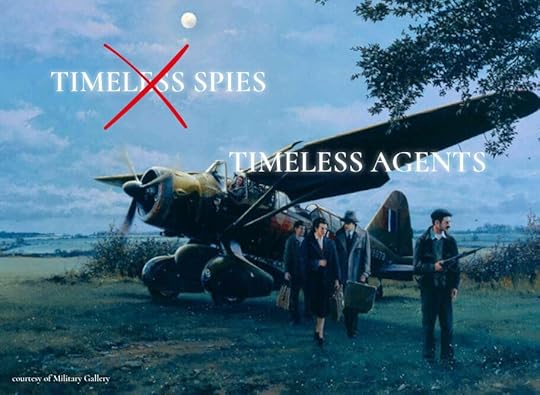
With this in mind, I decided to change the title of my series from Timeless Spies to Timeless Agents. While you, my readers, might see "spy" being used everywhere, I want to make sure I honor the legacy of these legends. The way they really saw themselves.
So, in my work they will only be called SECRET AGENTS.
If all goes well, the Timeless Agents series will ultimately honor all 39 female secret agents of Section France.
One week now until the first book, The Color of Courage, goes live. Oh, it's so exciting.
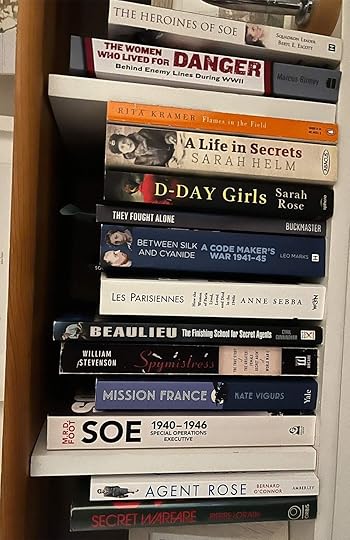
Part of my library on SOE
Here's an early 5-star review from one of my ARC team members:
"I’ve read all of Hannah’s books and enjoy the way that she mixes fact and fiction. This particular book tells the story of one of the bravest SOE agents intertwined with a modern day romance. This series will bring the actions of Resistance fighters to a brand new audience." ~ Fiona
If you haven't preordered The Color of Courage yet, click the link! 👇😊
 Pre order The Color Of Courage
Pre order The Color Of Courage



